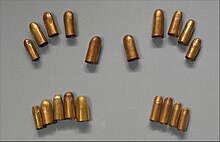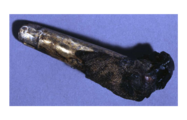170:
383:
146:
27:
158:
74:, as well as other eras, and were thought to protect the deceased from both magical and physical dangers, such as damage which could occur during the mummification process. Additionally, they were sometimes used in order to replace missing digits on the deceased, as it was believed that a complete body was needed for successful passage into the afterlife. This belief mirrors the myth of
130:. For example, one mummy from this period was found with carved golden finger stalls, similar to those discovered from earlier periods. Though royalty and the upper classes typically had stalls made of gold or silver, less wealthy Egyptians utilized other materials, including wood, stone, and/or mud. In order to provide magical protection for the deceased, a prayer was made to
86:. Some mummies were buried with prosthetics which they used in life, rather than toe stalls created specifically for burial. These stalls were most commonly found on the remains of royalty. Toe stalls were discovered in the tomb of
169:
31:
A set of finger and toe stalls belonging to one of the foreign wives of
Thutmose III, dating to the 15th century B.C. Now in the Metropolitan Museum of Art
424:
329:
265:
453:
417:
115:
134:
as the stalls were created. The stalls were often highly detailed, with carved nails and other features, such as rings.
448:
119:
107:
103:
145:
241:
410:
91:
157:
443:
71:
382:
335:
325:
220:
123:
394:
353:
26:
67:
295:
106:. The stalls from this tomb are some of the earliest known, originating from the early
242:"Hatshepsut: From Queen to Pharaoh - MetPublications - the Metropolitan Museum of Art"
437:
99:
51:
118:
ruler. Although many surviving examples of finger and toe stalls originate from the
95:
90:, and a nearly complete set of finger and toe stalls was discovered in the tomb of
209:"Reproducing human limbs. Prosthesis, amulets and votive objects in Ancient Egypt"
127:
111:
87:
390:
224:
339:
208:
131:
75:
319:
83:
321:
Egyptian mummies : unravelling the secrets of an ancient art
110:. A later surviving example of toe stalls comes from the tomb of
79:
63:
122:, they were used for much of Ancient Egypt, including into the
398:
266:"Tutankhamun: The Golden King and the Great Pharaohs"
102:. The wives' jewelry is currently on display at the
47:
36:
70:during burial. Such stalls were used during the
78:, whose body was put back together by his wife
418:
8:
213:Res Antiquitatis. Journal of Ancient History
19:
425:
411:
25:
18:
66:jewelry used in Ancient Egypt to protect
186:
141:
82:, resulting in him becoming the first
7:
379:
377:
313:
311:
290:
288:
286:
236:
234:
202:
200:
198:
196:
194:
192:
190:
175:Mummy finger encased in silver stall
397:. You can help Knowledge (XXG) by
14:
381:
168:
156:
144:
354:"finger-stall | British Museum"
207:Colazilli, Alessandra (2012).
60:Egyptian finger and toe stalls
1:
40:
470:
376:
104:Metropolitan Museum of Art
24:
324:. Michael O'Mara Books.
16:Ancient Egyptian jewelry
454:African studies stubs
72:18th Dynasty of Egypt
318:Bob., Brier (1997).
20:Finger and toe stall
449:Ancient Egypt stubs
389:This article about
296:"www.metmuseum.org"
270:Wandering Educators
21:
358:The British Museum
92:three of the wives
406:
405:
246:www.metmuseum.org
57:
56:
461:
427:
420:
413:
385:
378:
368:
367:
365:
364:
350:
344:
343:
315:
306:
305:
303:
302:
292:
281:
280:
278:
277:
262:
256:
255:
253:
252:
238:
229:
228:
204:
172:
160:
148:
42:
29:
22:
469:
468:
464:
463:
462:
460:
459:
458:
434:
433:
432:
431:
374:
372:
371:
362:
360:
352:
351:
347:
332:
317:
316:
309:
300:
298:
294:
293:
284:
275:
273:
264:
263:
259:
250:
248:
240:
239:
232:
206:
205:
188:
183:
176:
173:
164:
161:
152:
149:
140:
32:
17:
12:
11:
5:
467:
465:
457:
456:
451:
446:
436:
435:
430:
429:
422:
415:
407:
404:
403:
386:
370:
369:
345:
330:
307:
282:
257:
230:
185:
184:
182:
179:
178:
177:
174:
167:
165:
162:
155:
153:
151:A finger stall
150:
143:
139:
136:
62:are pieces of
55:
54:
49:
45:
44:
38:
34:
33:
30:
15:
13:
10:
9:
6:
4:
3:
2:
466:
455:
452:
450:
447:
445:
444:Ancient Egypt
442:
441:
439:
428:
423:
421:
416:
414:
409:
408:
402:
400:
396:
392:
387:
384:
380:
375:
359:
355:
349:
346:
341:
337:
333:
331:1-85479-636-4
327:
323:
322:
314:
312:
308:
297:
291:
289:
287:
283:
271:
267:
261:
258:
247:
243:
237:
235:
231:
226:
222:
218:
214:
210:
203:
201:
199:
197:
195:
193:
191:
187:
180:
171:
166:
159:
154:
147:
142:
137:
135:
133:
129:
128:Roman periods
125:
121:
117:
113:
109:
105:
101:
97:
93:
89:
85:
81:
77:
73:
69:
65:
61:
53:
52:Ancient Egypt
50:
46:
43:1500–1000 B.C
39:
35:
28:
23:
399:expanding it
388:
373:
361:. Retrieved
357:
348:
320:
299:. Retrieved
274:. Retrieved
272:. 2012-02-02
269:
260:
249:. Retrieved
245:
216:
212:
120:18th Dynasty
116:21st Dynasty
108:18th Dynasty
96:Thutmose III
59:
58:
37:Years active
219:: 147–174.
163:A toe stall
112:Psusennes I
88:Tutankhamun
438:Categories
391:Egyptology
363:2021-04-27
301:2018-08-11
276:2018-08-11
251:2021-04-29
181:References
225:1647-5852
124:Ptolemaic
340:59649679
48:Location
138:Gallery
338:
328:
223:
132:Osiris
100:Thebes
76:Osiris
68:digits
393:is a
84:mummy
395:stub
336:OCLC
326:ISBN
221:ISSN
126:and
114:, a
80:Isis
64:gold
98:in
94:of
440::
356:.
334:.
310:^
285:^
268:.
244:.
233:^
215:.
211:.
189:^
41:c.
426:e
419:t
412:v
401:.
366:.
342:.
304:.
279:.
254:.
227:.
217:3
Text is available under the Creative Commons Attribution-ShareAlike License. Additional terms may apply.





